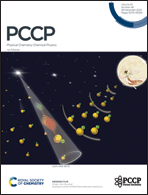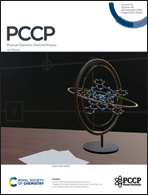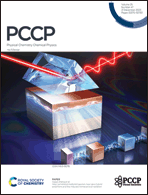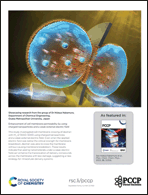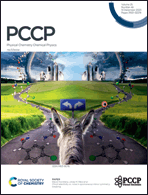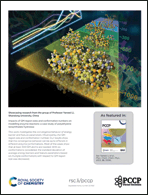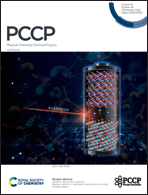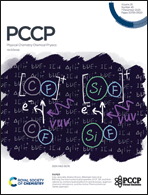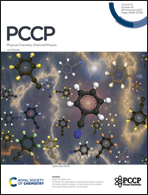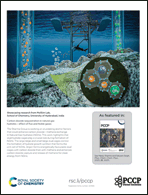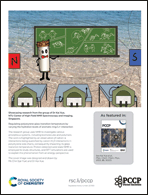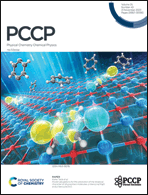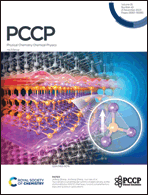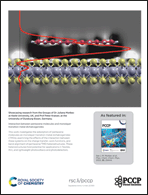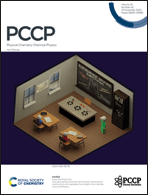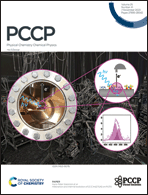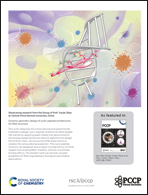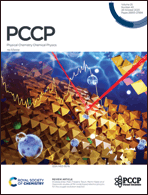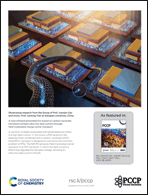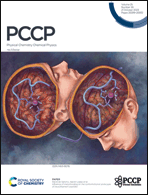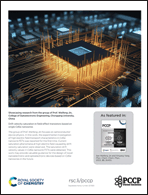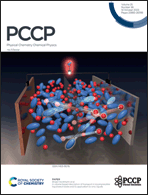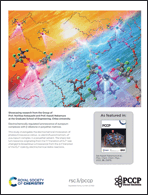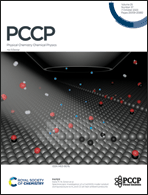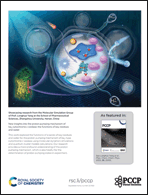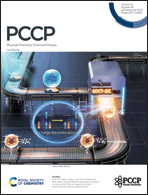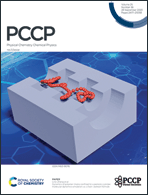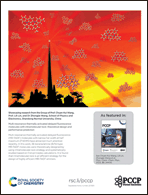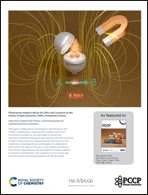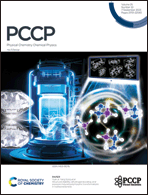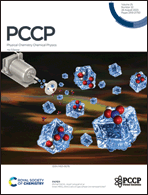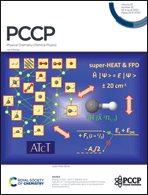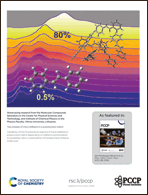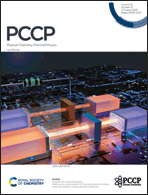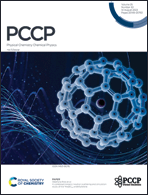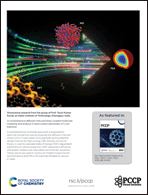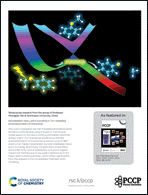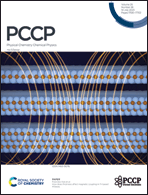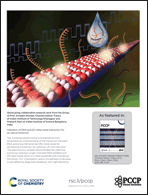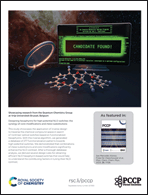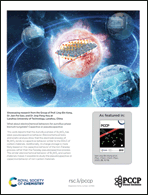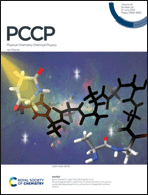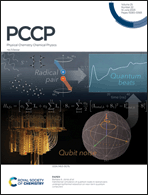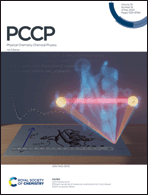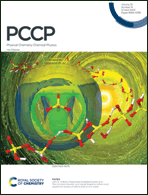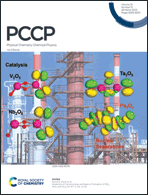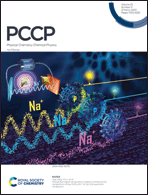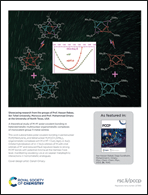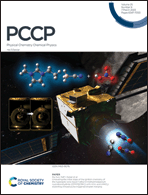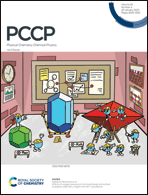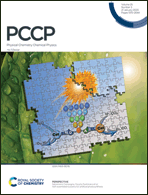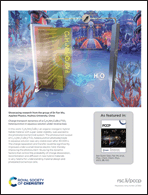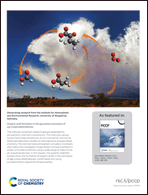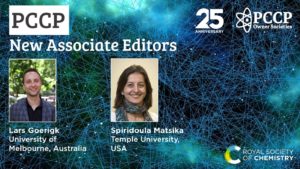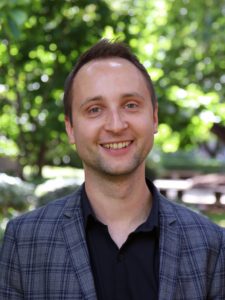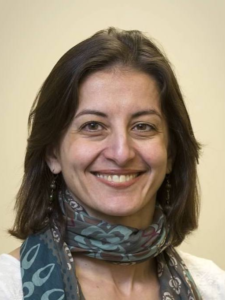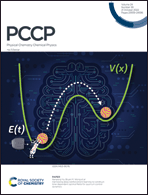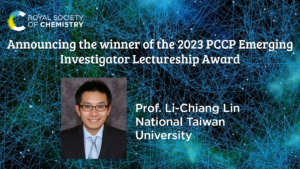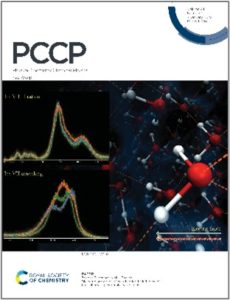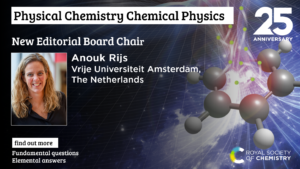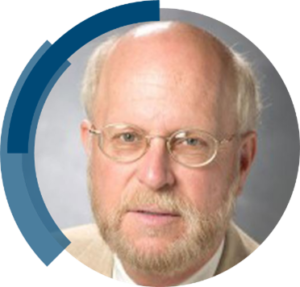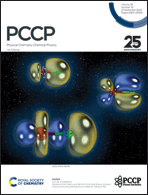 |
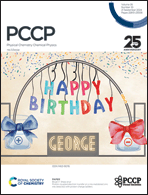 |
||
| Wavefunction theory and density functional theory analysis of ground and excited electronic states of TaB and WB
Isuru R. Ariyarathna Phys. Chem. Chem. Phys., 2024, 26, 22858 DOI:10.1039/D4CP02202E |
Proton-coupled electron transfer at a mis-metalated zinc site detected with protein charge ladders
Mayte Gonzalez, Matthew J. Guberman-Pfeffer, Jordan C. Koone, Chad M. Dashnaw, Travis J. Lato and Bryan F. Shaw Phys. Chem. Chem. Phys., 2024, 26, 22870 DOI:10.1039/D4CP01989J |
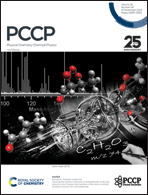 |
|||
| Tracking the reaction networks of acetaldehyde oxide and glyoxal oxide Criegee intermediates in the ozone-assisted oxidation reaction of crotonaldehyde
Alec C. DeCecco, Alan R. Conrad, Arden M. Floyd, Ahren W. Jasper, Nils Hansen, Philippe Dagaut, Nath-Eddy Moody and Denisia M. Popolan-Vaida Phys. Chem. Chem. Phys., 2024, 26, 22319 DOI:10.1039/D4CP01942C |
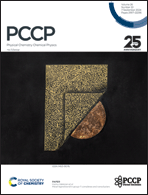 |
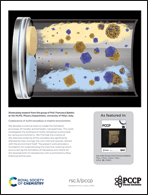 |
||
| Metal–ligand bond in group-11 complexes and nanoclusters
Maryam Sabooni Asre Hazer, Sami Malola and Hannu Häkkinen Phys. Chem. Chem. Phys., 2024, 26, 21954 DOI:10.1039/D4CP00848K |
Coalescence of AuPd nanoalloys in implicit environments
Sofia Zinzani and Francesca Baletto Phys. Chem. Chem. Phys., 2024, 26, 21965 DOI:10.1039/D4CP00916A |
 |
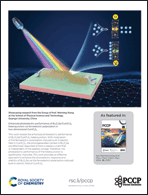 |
||
| Exploring Cr and molten salt interfacial interactions for molten salt applications
Xiaoyang Liu, Yang Liu, Luke D. Gibson, Mingyuan Ge, Daniel Olds, Denis Leshchev, Jianming Bai, Anna M. Plonka, Phillip Halstenberg, Hui Zhong, Sanjit Ghose, Cheng-Hung Lin, Xiaoyin Zheng, Xianghui Xiao, Wah-Keat Lee, Sheng Dai, German D. Samolyuk, Vyacheslav S. Bryantsev, Anatoly I. Frenkel and Yu-chen Karen Chen-Wiegart Phys. Chem. Chem. Phys., 2024, 26, 21342 DOI:10.1039/D4CP01122H |
Enhanced photoelectric performance of Bi2O2Se/CuInP2S6 heterojunction via ferroelectric polarization in two-dimensional CuInP2S6
Di Wang, Qiong Wu, Kaihan Shan, Mengwei Han, Wenyu Jiang, Weiting Meng, Yanqing Zhang and Weiming Xiong Phys. Chem. Chem. Phys., 2024, 26, 21357 DOI:10.1039/D4CP02367F |
 |
|||
| A first-principles alternative to empirical solvent parameters
Kasimir P. Gregory, Erica J. Wanless, Grant B. Webber, Vincent S. J. Craig and Alister J. Page Phys. Chem. Chem. Phys., 2024, 26, 20750 DOI:10.1039/D4CP01975J |
 |
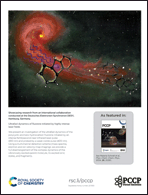 |
||
| Theoretical search for characteristic atoms in supported gold nanoparticles: a large-scale DFT study
Shengzhou Li, Tsuyoshi Miyazaki and Ayako Nakata Phys. Chem. Chem. Phys., 2024, 26, 20251 DOI:10.1039/D4CP01094A |
Ultrafast dynamics of fluorene initiated by highly intense laser fields
Diksha Garg, Pragya Chopra, Jason W. L. Lee, Denis S. Tikhonov, Sonu Kumar, Oender Akcaalan, Felix Allum, Rebecca Boll, Alexander A. Butler, Benjamin Erk, Eva Gougoula, Sébastien P. Gruet, Lanhai He, David Heathcote, Ellen Jones, Mehdi M. Kazemi, Jan Lahl, Alexander K. Lemmens, Zhihao Liu, Donatella Loru, Sylvain Maclot, Robert Mason, James Merrick, Erland Müller, Terry Mullins, Christina C. Papadopoulou, Christopher Passow, Jasper Peschel, Marius Plach, Daniel Ramm, Patrick Robertson, Dimitrios Rompotis, Alcides Simao, Amanda L. Steber, Ayhan Tajalli, Atia Tul-Noor, Nidin Vadassery, Ivo S. Vinklárek, Simone Techert, Jochen Küpper, Anouk M. Rijs, Daniel Rolles, Mark Brouard, Sadia Bari, Per Eng-Johnsson, Claire Vallance, Michael Burt, Bastian Manschwetus and Melanie Schnell Phys. Chem. Chem. Phys., 2024, 26, 20261 DOI:10.1039/D3CP05063G |
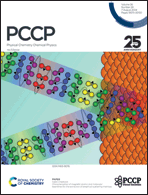 |
 |
||
| Characterisation of magnetic atomic and molecular beamlines for the extraction of empirical scattering-matrices
Helen Chadwick Phys. Chem. Chem. Phys., 2024, 26, 19630 DOI:10.1039/D4CP01785D |
The electronic structure of diatomic nickel oxide
Nickolas A. Joyner, João Gabriel Farias Romeu, Brian Kent and David A. Dixon Phys. Chem. Chem. Phys., 2024, 26, 19646 DOI:10.1039/D4CP01796J |
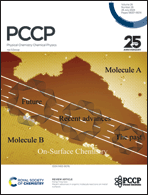 |
 |
||
| Recent advances in organic molecule reactions on metal surfaces
Hong-Ying Gao Phys. Chem. Chem. Phys., 2024, 26, 19052 DOI:10.1039/D3CP06148E |
A systematic theoretical study of CO2 hydrogenation towards methanol on Cu-based bimetallic catalysts: role of the CHO&CH3OH descriptor in thermodynamic analysis
Huang Qin, Hai Zhang, Kunmin Wu, Xingzi Wang and Weidong Fan Phys. Chem. Chem. Phys., 2024, 26, 19088 DOI:10.1039/D4CP01009D |
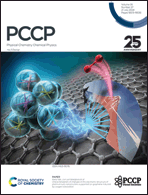 |
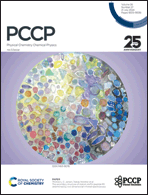 |
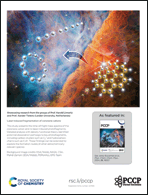 |
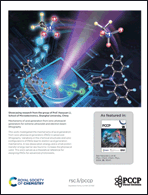 |
| Characterization of changes in the electronic structure of platinum sub-nanoclusters supported on graphene induced by oxygen adsorption
Hinoki Hirase, Kenji Iida and Jun-ya Hasegawa Phys. Chem. Chem. Phys., 2024, 26, 18530 DOI:10.1039/D4CP00555D |
The secondary structure of diatom silaffin peptide R5 determined by two-dimensional infrared spectroscopy
Asger Berg Thomassen, Thomas L. C. Jansen and Tobias Weidner Phys. Chem. Chem. Phys., 2024, 26, 18538 DOI:10.1039/D4CP00970C |
Laser-induced fragmentation of coronene cations
Sanjana Panchagnula, Jerry Kamer, Alessandra Candian, Helgi R. Hrodmarsson, Harold Linnartz, Jordy Bouwman and Alexander G. G. M. Tielens Phys. Chem. Chem. Phys., 2024, 26, 18557 DOI:10.1039/D4CP01301H |
Mechanisms of acid generation from ionic photoacid generators for extreme ultraviolet and electron beam lithography
Chengbin Fu, Kun Du, Jie Xue, Hanshen Xin, Jianhua Zhang and Haoyuan Li Phys. Chem. Chem. Phys., 2024, 26, 18547 DOI:10.1039/D4CP01814A |
 |
 |
||
| Low-temperature redox activity and alcohol ammoxidation performance on Cu- and Ru-incorporated ceria catalysts
Chaoqi Chen, Satoru Ikemoto, Gen-ichi Yokota, Kimitaka Higuchi, Satoshi Muratsugu and Mizuki Tada Phys. Chem. Chem. Phys., 2024, 26, 17979 DOI:10.1039/D4CP01432D |
Photo-induced structural dynamics of o-nitrophenol by ultrafast electron diffraction
J. P. F. Nunes, M. Williams, J. Yang, T. J. A. Wolf, C. D. Rankine, R. Parrish, B. Moore, K. Wilkin, X. Shen, Ming-Fu Lin, K. Hegazy, R. Li, S. Weathersby, T. J. Martinez, X. J. Wang and M. Centurion Phys. Chem. Chem. Phys., 2024, 26, 17991 DOI:10.1039/D3CP06253H |
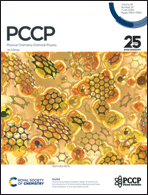 |
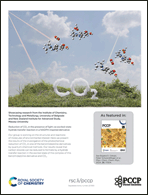 |
||
| Microhydration of small protonated polyaromatic hydrocarbons: a first principles study
Muthuramalingam Prakash, K. Rudharachari Maiyelvaganan, N. Giri Lakshman, C. Gopalakrishnan and Majdi Hochlaf Phys. Chem. Chem. Phys., 2024, 26, 17489 DOI:10.1039/D3CP06000D |
Reduction of CO2 in the presence of light via excited-state hydride transfer reaction in a NADPH-inspired derivative
Bojana D. Ostojić, Branislav Stanković, Dragana S. Đorđević and Peter Schwerdtfeger Phys. Chem. Chem. Phys., 2024, 26, 17504 DOI:10.1039/D3CP05635J |
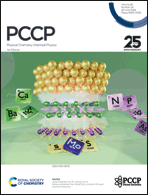 |
 |
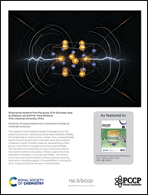 |
|
| Designing barrier-free metal/MoS2 contacts through electrene insertion
Mohammad Rafiee Diznab, Adrian F. Rumson, Jesse Maassen and Erin R. Johnson Phys. Chem. Chem. Phys., 2024, 26, 16947 DOI:10.1039/D3CP06112D |
Thermodynamics of resonating-valence-bond states toward the understanding of quantum spin liquid phenomena
Florentino López-Urías, Alberto Rubio-Ponce, Emilio Muñoz-Sandoval and Francisco Sánchez-Ochoa Phys. Chem. Chem. Phys., 2024, 26, 16955 DOI:10.1039/D4CP01008F |
Discovery of superconductivity in technetium borides at moderate pressures
Xiangru Tao, Aiqin Yang, Yundi Quan, Biao Wan, Shuxiang Yang and Peng Zhang Phys. Chem. Chem. Phys., 2024, 26, 16963 DOI:10.1039/D4CP00191E |
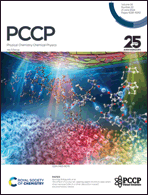 |
 |
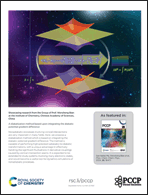 |
|
| The effect of a polymer capping agent on electrodeposited silver nanoparticles in a silver deposition-based electrochromic device
Shun Uji, Kazuki Nakamura and Norihisa Kobayashi Phys. Chem. Chem. Phys., 2024, 26, 16466 DOI:10.1039/D3CP06281C |
Entropy-ruled nonequilibrium charge transport in thiazolothiazole-based molecular crystals: a quantum chemical study
M. Pavalamuthu and K. Navamani Phys. Chem. Chem. Phys., 2024, 26, 16488 DOI:10.1039/D3CP05739A |
A diabatization method based upon integrating the diabatic potential gradient difference
Fengyi Li, Xiaoxi Liu, Haitao Ma and Wensheng Bian Phys. Chem. Chem. Phys., 2024, 26, 16477 DOI:10.1039/D4CP00375F |
 |
 |
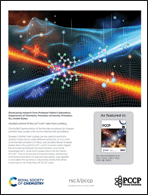 |
|
| First-principles mode-specific reaction dynamics
Gábor Czakó, Balázs Gruber, Dóra Papp, Viktor Tajti, Domonkos A. Tasi and Cangtao Yin Phys. Chem. Chem. Phys., 2024, 26, 15818 DOI:10.1039/D4CP00417E |
An integrated approach towards extracting structural characteristics of chlorosomes from a bchQ mutant of Chlorobaculum tepidum Lolita Dsouza, Xinmeng Li, Vesna Erić, Annemarie Huijser, Thomas L. C. Jansen, Alfred R. Holzwarth, Francesco Buda, Donald A. Bryant, Salima Bahri, Karthick Babu Sai Sankar Gupta, G. J. Agur Sevink and Huub J. M. de GrootPhys. Chem. Chem. Phys., 2024, 26, 15856 DOI:10.1039/D4CP00221K |
Ultrafast control of the LnF+/LnO+ ratio from Ln(hfac)3 Jiangchao Chen, Xi Xing, Roberto Rey-de-Castro and Herschel RabitzPhys. Chem. Chem. Phys., 2024, 26, 15850 DOI:10.1039/D4CP00337C |
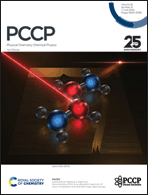 |
 |
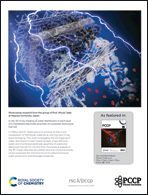 |
|
| Deconvolution of the X-ray absorption spectrum of trans-1,3-butadiene with resonant Auger spectroscopy
David M. P. Holland, Jiří Suchan, Jiří Janoš, Camila Bacellar, Ludmila Leroy, Thomas R. Barillot, Luca Longetti, Marcello Coreno, Monica de Simone, Cesare Grazioli, Majed Chergui, Eva Muchová and Rebecca A. Ingle Phys. Chem. Chem. Phys., 2024, 26, 15130 DOI:10.1039/D4CP00053F |
Metal–ring interactions in group 2 ansa-metallocenes: assessed with the local vibrational mode theory
Juliana J. Antonio and Elfi Kraka Phys. Chem. Chem. Phys., 2024, 26, 15143 DOI:10.1039/D4CP00225C |
In situ 3D X-ray imaging of water distribution in each layer of a membrane electrode assembly of a polymer electrolyte fuel cell
Hirosuke Matsui, Tomoro Ohta, Takahiro Nakamura, Tomoya Uruga and Mizuki Tada Phys. Chem. Chem. Phys., 2024, 26, 15115 DOI:10.1039/D4CP00728J |
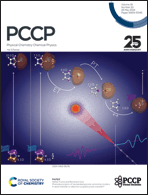 |
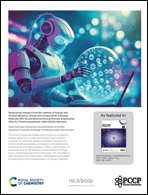 |
||
| Photodissociation of deuterated pyrrole–ammonia clusters: H-atom transfer or electron coupled proton transfer? Stefan Fuchs and Bernhard DickPhys. Chem. Chem. Phys., 2024, 26, 14514 DOI:10.1039/D4CP00566J |
Deep learning-enhanced characterization of bubble dynamics in proton exchange membrane water electrolyzers André Colliard-Granero, Keusra A. Gompou, Christian Rodenbücher, Kourosh Malek, Michael H. Eikerling and Mohammad J. EslamibidgoliPhys. Chem. Chem. Phys., 2024, 26, 14529 DOI:10.1039/D3CP05869G |
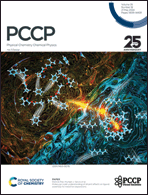 |
 |
||
| Molecular-scale understanding of diluent effects on ligand assembly for metal ion separations
Derrick Poe, Soenke Seifert and Michael J. Servis Phys. Chem. Chem. Phys., 2024, 26, 14108 DOI:10.1039/D3CP05972C |
Exploring thermodynamic stability of plutonium oxycarbide using a machine-learning scheme
Ruizhi Qiu, Jun Tang, Jinfan Chen, Pengchuang Liu and Qi Wang Phys. Chem. Chem. Phys., 2024, 26, 14122 DOI:10.1039/D3CP05249D |
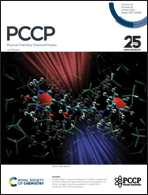 |
 |
 |
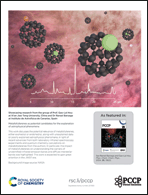 |
| Dynamic effects on the nonlinear optical properties of donor acceptor stenhouse adducts: insights from combined MD + QM simulations
Angela Dellai, Carmelo Naim, Javier Cerezo, Giacomo Prampolini and Frédéric Castet Phys. Chem. Chem. Phys., 2024, 26, 13639 DOI:10.1039/D4CP00310A |
Nature of Li2O2 and its relationship to the mechanisms of discharge/charge reactions of lithium–oxygen batteries
Yanan Gao, Hitoshi Asahina, Shoichi Matsuda, Hidenori Noguchi and Kohei Uosaki Phys. Chem. Chem. Phys., 2024, 26, 13655 DOI:10.1039/D4CP00428K |
The structure-giving role of Rb+ ions for water–ice nanoislands supported on Cu(111)
Javier A. Martínez, Inga C. Langguth, David Olivenza-León and Karina Morgenstern Phys. Chem. Chem. Phys., 2024, 26, 13667 DOI:10.1039/D3CP05968E |
Metallofullerenes as potential candidates for the explanation of astrophysical phenomena
Ransel Barzaga and Gao-Lei Hou Phys. Chem. Chem. Phys., 2024, 26, 13622 DOI:10.1039/D4CP00146J |
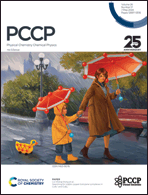 |
 |
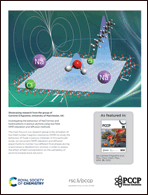 |
|
| Searching for stable copper borozene complexes in CuB7− and CuB8−
Wei-Jia Chen, Anton S. Pozdeev, Hyun Wook Choi, Alexander I. Boldyrev, Dao-Fu Yuan, Ivan A. Popov and Lai-Sheng Wang Phys. Chem. Chem. Phys., 2024, 26, 12928 DOI:10.1039/D4CP00296B |
Combining high energy ball milling and liquid crystal templating method to prepare magnetic ordered mesoporous silica. A physico-chemical investigation
Alessandra Scano, Edmond Magner, Martina Pilloni, Luciano Atzori, Marzia Fantauzzi, Sawssen Slimani, Davide Peddis, Gonzalo Garcia Fuentes and Guido Ennas Phys. Chem. Chem. Phys., 2024, 26, 13020 DOI:10.1039/D3CP04213H |
Investigating the behaviour of NaCl brines and hydrocarbons in porous alumina using low-field NMR relaxation and diffusion methods
Aristarchos Mavridis, Mark Sankey, Kuhan Chellappah and Carmine D’Agostino Phys. Chem. Chem. Phys., 2024, 26, 13012 DOI:10.1039/D4CP00361F |
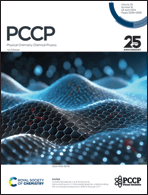 |
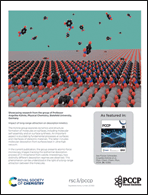 |
||
| Nano-protrusions in intercalated graphite: understanding the structural and electronic effects through DFT
Hussam Bouaamlat, Ari Paavo Seitsonen, Gianlorenzo Bussetti, Rossella Yivlialin, Stefania De Rosa, Paolo Branchini and Luca Tortora Phys. Chem. Chem. Phys., 2024, 26, 12269 DOI:10.1039/D3CP05706B |
Impact of long-range attraction on desorption kinetics
Florian Schneider, Lukas Höltkemeier, Andrea Floris, Lev Kantorovich, Ralf Bechstein and Angelika Kühnle Phys. Chem. Chem. Phys., 2024, 26, 12282 DOI:10.1039/D3CP05465A |
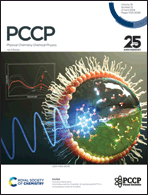 |
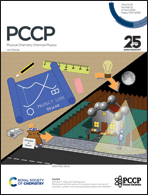 |
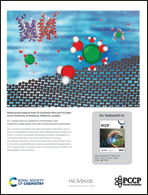 |
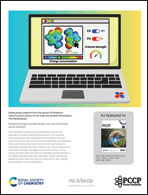 |
| Anomalous proton transfer of a photoacid HPTS in nonaqueous reverse micelles
Taehyung Jang, Sebok Lee and Yoonsoo Pang Phys. Chem. Chem. Phys., 2024, 26, 11283 DOI:10.1039/D3CP05710K |
Photochemical formation of the elusive Dewar isomers of aromatic systems: why are substituted azaborines different?
Enrique M. Arpa, Sven Stafström and Bo Durbeej Phys. Chem. Chem. Phys., 2024, 26, 11295 DOI:10.1039/D4CP00777H |
Cs+ conductance in graphene membranes with Ångström-scale pores: the role of pore entrance geometry
Enrique Wagemann, Na Young Kim and Sushanta K. Mitra Phys. Chem. Chem. Phys., 2024, 26, 11311 DOI:10.1039/D4CP00400K |
Multiple hydrogen-bonded dimers: are only the frontier atoms relevant?
Celine Nieuwland, David Almacellas, Mac M. Veldhuizen, Lucas de Azevedo Santos, Jordi Poater and Célia Fonseca Guerra Phys. Chem. Chem. Phys., 2024, 26, 11306 DOI:10.1039/D3CP05244C |
 |
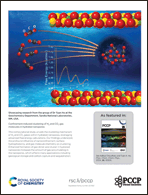 |
||
| Predicting two-dimensional semiconductors using conductivity effective mass
Wenjun Zhang, Zhikun Yao and Lee A. Burton Phys. Chem. Chem. Phys., 2024, 26, 10520 DOI:10.1039/D4CP00277F |
Confinement-induced clustering of H2 and CO2 gas molecules in hydrated nanopores
Aditya Choudhary and Tuan A. Ho Phys. Chem. Chem. Phys., 2024, 26, 10506 DOI:10.1039/D3CP06024A |
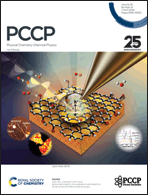 |
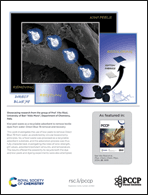 |
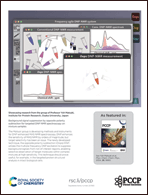 |
|
| Nanoscale insights into graphene oxide reduction by tip-enhanced Raman spectroscopy
Xiao You, Sangita Maharjan, Kizhanipuram Vinodgopal and Joanna M. Atkin Phys. Chem. Chem. Phys., 2024, 26, 9871 DOI:10.1039/D3CP04711C |
Kiwi peel waste as a recyclable adsorbent to remove textile dyes from water: Direct Blue 78 removal and recovery
Jennifer Gubitosa, Vito Rizzi, Paola Fini, Sergio Nuzzo and Pinalysa Cosma Phys. Chem. Chem. Phys., 2024, 26, 9891 DOI:10.1039/D4CP00174E |
Background signal suppression by opposite polarity subtraction for targeted DNP NMR spectroscopy on mixture samples
Zhongliang Zhang, Ken Kato, Hajime Tamaki and Yoh Matsuki Phys. Chem. Chem. Phys., 2024, 26, 9880 DOI:10.1039/D3CP06280E |
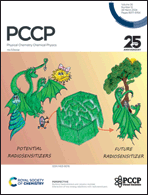 |
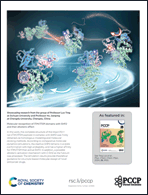 |
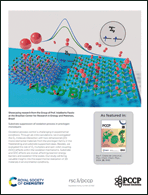 |
|
| Interaction of low-energy electrons with radiosensitizers
Barbora Sedmidubská and Jaroslav Kočišek Phys. Chem. Chem. Phys., 2024, 26, 9112 DOI:10.1039/D3CP06003A |
Molecular recognition of ITIM/ITSM domains with SHP2 and their allosteric effect
Yan Cheng, Weiwei Ouyang, Ling Liu, Lingkai Tang, Zhigang Zhang, Xinru Yue, Li Liang, Jianping Hu and Ting Luo Phys. Chem. Chem. Phys., 2024, 26, 9155 DOI:10.1039/D3CP03923D |
Substrate suppression of oxidation process in pnictogen monolayers
Rafael L. H. Freire, F. Crasto de Lima and A. Fazzio Phys. Chem. Chem. Phys., 2024, 26, 9149 DOI:10.1039/D3CP03976E |
 |
 |
||
| Electron doping as a handle to increase the Curie temperature in ferrimagnetic Mn3Si2X6 (X = Se, Te)
Lei Qiao, Paolo Barone, Baishun Yang, Phil D.C. King, Wei Ren and Silvia Picozzi Phys. Chem. Chem. Phys., 2024, 26, 8604 DOI:10.1039/D3CP05525F |
A density functional theory benchmark on antioxidant-related properties of polyphenols
Rodrigo A. Mendes, Victor A. S. da Mata, Alex Brown and Gabriel L. C. de Souza Phys. Chem. Chem. Phys., 2024, 26, 8613 DOI:10.1039/D3CP04412B |
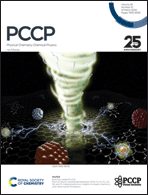 |
 |
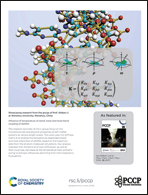 |
|
| Electron beam-induced demetallation of Fe, Co, Ni, Cu, Zn, Pd, and Pt metalloporphyrins: insights in e-beam chemistry and metal cluster formations
Jongseong Park, Sol Lee, Orein Francis Jafter, Jinwoo Cheon and Dominik Lungerich Phys. Chem. Chem. Phys., 2024, 26, 8051 DOI:10.1039/D3CP05848D |
Poly(dimethylsiloxane) as a room-temperature solid solvent for photophysics and photochemistry
John A. Clark, Samantha Robinson, Eli M. Espinoza, Duoduo Bao, James B. Derr, Luca Croft, Omar O’Mari, William H. Grover and Valentine I. Vullev Phys. Chem. Chem. Phys., 2024, 26, 8062 DOI:10.1039/D3CP05413F |
Influence of temperature on bend, twist and twist–bend coupling of dsDNA
Zihao Zhang, Xuankang Mou, Yahong Zhang, Linli He and Shiben Li Phys. Chem. Chem. Phys., 2024, 26, 8077 DOI:10.1039/D3CP04932A |
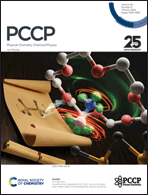 |
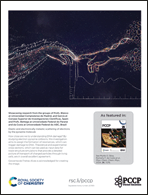 |
||
| A confinement-regulated (H3C–NH3)+ ion as a smallest dual-wheel rotator showing bisected rotation dynamics
Wang Li, Miao Xie, Shi-Yong Zhang, Cheng-Hui Zeng, Zi-Yi Du and Chun-Ting He Phys. Chem. Chem. Phys., 2024, 26, 7269 DOI:10.1039/D3CP05406C |
Elastic and electronically inelastic scattering of electrons by the pyrazine molecule
Murilo O. Silva, Giseli M. Moreira, Jaime Rosado, Francisco Blanco, Gustavo García, Márcio H. F. Bettega and Romarly F. da Costa Phys. Chem. Chem. Phys., 2024, 26, 7276 DOI:10.1039/D3CP04619B |
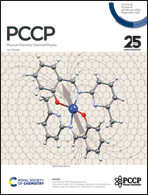 |
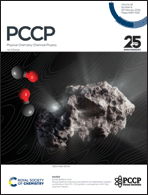 |
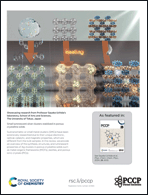 |
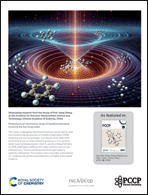 |
| Tetracoordinate Co(II) complexes with semi-coordination as stable single-ion magnets for deposition on graphene
Jorge Navarro Giraldo, Jakub Hrubý, Šárka Vavrečková, Ondřej F. Fellner, Lubomír Havlíček, DaVonne Henry, Shehan de Silva, Radovan Herchel, Miroslav Bartoš, Ivan Šalitroš, Vinicius T. Santana, Paola Barbara, Ivan Nemec and Petr Neugebauer Phys. Chem. Chem. Phys., 2023, 25, 29516 DOI:10.1039/D3CP01426F |
Mixed quantum/classical calculations of rotationally inelastic scattering in the CO + CO system: a comparison with fully quantum results
Dulat Bostan, Bikramaditya Mandal, Carolin Joy, Michał Żółtowski, François Lique, Jérôme Loreau, Ernesto Quintas-Sánchez, Adrian Batista-Planas, Richard Dawes and Dmitri Babikov Phys. Chem. Chem. Phys., 2024, 26, 6627 DOI:10.1039/D3CP05369E |
Small luminescent silver clusters stabilized in porous crystalline solids
Naoya Haraguchi, Taisei Kurosaki and Sayaka Uchida Phys. Chem. Chem. Phys., 2024, 26, 6512 DOI:10.1039/D3CP04589G |
Photochemical mechanistic study of hexafluorobenzene involving the low-lying states
Duoduo Li, Xinli Song, Jinming Liu and Song Zhang Phys. Chem. Chem. Phys., 2024, 26, 6638 DOI:10.1039/D3CP04184K |
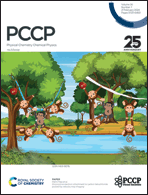 |
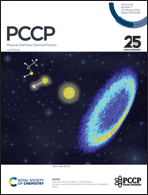 |
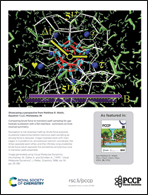 |
|
| Dissociative electron attachment to carbon tetrachloride probed by velocity map imaging
Anirban Paul, Dhananjay Nandi, Daniel S. Slaughter, Juraj Fedor and Pamir Nag Phys. Chem. Chem. Phys., 2024, 26, 5783 DOI:10.1039/D3CP04834A |
Dynamics of dissociative electron attachment to aliphatic thiols
Sukanta Das and Vaibhav S. Prabhudesai Phys. Chem. Chem. Phys., 2024, 26, 5793 DOI:10.1039/D3CP05456J |
Comparing brute force to transition path sampling for gas hydrate nucleation with a flat interface: comments on time reversal symmetry
Matthew R. Walsh Phys. Chem. Chem. Phys., 2024, 26, 5762 DOI:10.1039/D3CP05059A |
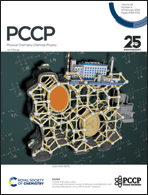 |
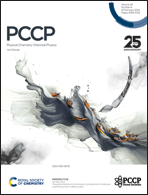 |
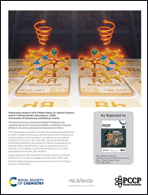 |
|
| A thorough mechanistic study of ethanol, acetaldehyde, and ethylene adsorption on Cu-MOR via DFT analysis
Yuli Ma and Junyu Lang Phys. Chem. Chem. Phys., 2024, 26, 4845 DOI:10.1039/D3CP05314H |
Theoretical trends in the dynamics simulations of molecular machines across multiple scales
Weijia Xu, Yuanda Tao, Haoyang Xu and Jin Wen Phys. Chem. Chem. Phys., 2024, 26, 4828 DOI:10.1039/D3CP05201J |
Chiroptical activity of benzannulated N-heterocyclic carbene rhenium(I) tricarbonyl halide complexes: towards efficient circularly polarized luminescence emitters
Valerio Giuso, Christophe Gourlaouen, Mathias Delporte–Pébay, Thomas Groizard, Nicolas Vanthuyne, Jeanne Crassous, Chantal Daniel and Matteo Mauro Phys. Chem. Chem. Phys., 2024, 26, 4855 DOI:10.1039/D3CP04300B |
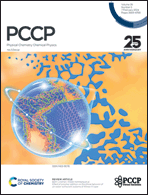 |
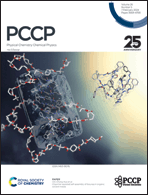 |
 |
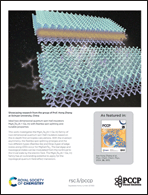 |
| Effect of polymer addition on the phase behavior of oil–water–surfactant systems of Winsor III type
Ming Lu, Björn Lindman and Krister Holmberg Phys. Chem. Chem. Phys., 2024, 26, 3699 DOI:10.1039/D3CP04730J |
Oligomer-assisted self-assembly of bisurea in organic solvent media
Ching-Hung Wu, Ling-Hua Huang and Chi-Chung Hua Phys. Chem. Chem. Phys., 2024, 26, 3810 DOI:10.1039/D3CP04464E |
Unexpected reduction in thermal conductivity observed in graphene/h-BN heterostructures
Zhang Wu, Rumeng Liu, Ning Wei and Lifeng Wang Phys. Chem. Chem. Phys., 2024, 26, 3823 DOI:10.1039/D3CP05407A |
Ideal two-dimensional quantum spin Hall insulators MgA2Te4 (A = Ga, In) with Rashba spin splitting and tunable properties
Jiaqi Li, Xinlu Cheng and Hong Zhang Phys. Chem. Chem. Phys., 2024, 26, 3815 DOI:10.1039/D3CP04898E |
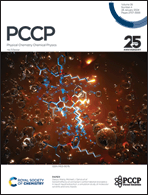 |
 |
 |
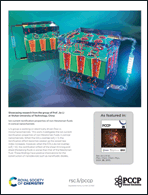 |
| Solvent effects on extractant conformational energetics in liquid–liquid extraction: a simulation study of molecular solvents and ionic liquids
Xiaoyu Wang, Srikanth Nayak, Richard E. Wilson, L. Soderholm and Michael J. Servis Phys. Chem. Chem. Phys., 2024, 26, 2877 DOI:10.1039/D3CP04680J |
Experimental phase diagram and its temporal evolution for submicron 2-methylglutaric acid and ammonium sulfate aerosol particles
Qishen Huang, Kiran R. Pitta, Kayla Constantini, Emily-Jean E. Ott, Andreas Zuend and Miriam Arak Freedman Phys. Chem. Chem. Phys., 2024, 26, 2887 DOI:10.1039/D3CP04411D |
An OrthoBoXY-method for various alternative box geometries
Johanna Busch and Dietmar Paschek Phys. Chem. Chem. Phys., 2024, 26, 2907 DOI:10.1039/D3CP04916G |
Ion current rectification properties of non-Newtonian fluids in conical nanochannels
Lei Tang, Yu Hao, Li Peng, Runxin Liu, Yi Zhou and Jie Li Phys. Chem. Chem. Phys., 2024, 26, 2895 DOI:10.1039/D3CP05184F |
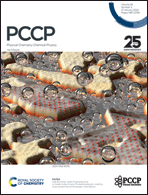 |
 |
 |
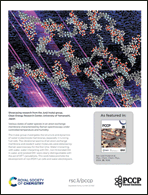 |
| A model study of ceria–Pt electrocatalysts: stability, redox properties and hydrogen intercalation
Lukáš Fusek, Pankaj Kumar Samal, Jiří Keresteš, Ivan Khalakhan, Viktor Johánek, Yaroslava Lykhach, Jörg Libuda, Olaf Brummel and Josef Mysliveček Phys. Chem. Chem. Phys., 2024, 26, 1630 DOI:10.1039/D3CP03831A |
Addressing electronic and dynamical evolution of molecules and molecular clusters: DFTB simulations of energy relaxation in polycyclic aromatic hydrocarbons
Mathias Rapacioli, Maysa Yusef Buey and Fernand Spiegelman Phys. Chem. Chem. Phys., 2024, 26, 1499 DOI:10.1039/D3CP02852F |
Analysis and interpretation of first passage time distributions featuring rare events
Esmae J. Woods and David J. Wales Phys. Chem. Chem. Phys., 2024, 26, 1640 DOI:10.1039/D3CP04199A |
Various states of water species in an anion exchange membrane characterized by Raman spectroscopy under controlled temperature and humidity
Solomon Wekesa Wakolo, Donald A. Tryk, Hiromichi Nishiyama, Kenji Miyatake, Akihiro Iiyama and Junji Inukai Phys. Chem. Chem. Phys., 2024, 26, 1658 DOI:10.1039/D3CP03660J |
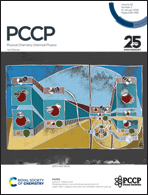 |
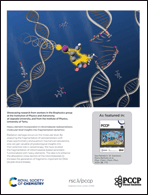 |
 |
|
| Modeling Henry’s law and phase separations of water–NaCl–organic mixtures with solvation and ion-pairing
Aaron D. Wilson, Zi Hao Foo, Ashini S. Jayasinghe, Caleb Stetson, Hyeonseok Lee, Harry W. Rollins, Akshay Deshmukh and John H. Lienhard Phys. Chem. Chem. Phys., 2024, 26, 749 DOI:10.1039/D3CP02003G |
Heavy element incorporation in nitroimidazole radiosensitizers: molecular-level insights into fragmentation dynamics
Pamela H. W. Svensson, Lucas Schwob, Oscar Grånäs, Isaak Unger, Olle Björneholm, Nicusor Timneanu, Rebecka Lindblad, Anna-Lydia Vieli, Vicente Zamudio-Bayer, Martin Timm, Konstantin Hirsch, Carl Caleman and Marta Berholts Phys. Chem. Chem. Phys., 2024, 26, 770 DOI:10.1039/D3CP03800A |
Bacterial model membranes under the harsh subsurface conditions of Mars
Attila Tortorella, Rosario Oliva, Concetta Giancola, Luigi Petraccone and Roland Winter Phys. Chem. Chem. Phys., 2024, 26, 760 DOI:10.1039/D3CP03911K |
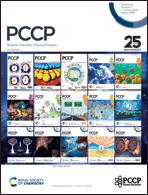 |
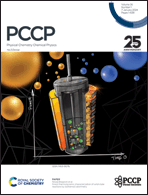 |
 |
 |
| The 25th Anniversary celebratory cover of PCCP
|
Direct thermodynamic characterization of solid-state reactions by isothermal calorimetry
Marija Cvetnić, Robert Šplajt, Edi Topić, Mirta Rubčić and Nikola Bregović Phys. Chem. Chem. Phys., 2024, 26, 67 DOI:10.1039/D3CP03933A |
Enhancing the upconversion of Er3+ incorporated BaTiO3 by introducing oxygen vacancies
Young Gwon Jung, Hyeongyu Bae and Kang Taek Lee Phys. Chem. Chem. Phys., 2024, 26, 76 DOI:10.1039/D3CP02133E |
Overcoming the barrier: designing novel thermally robust shape memory vitrimers by establishing a new machine learning framework
Cheng Yan, Xiaming Feng, John Konlan, Patrick Mensah and Guoqiang Li Phys. Chem. Chem. Phys., 2023, 25, 30049 DOI: 10.1039/D3CP03631F |











